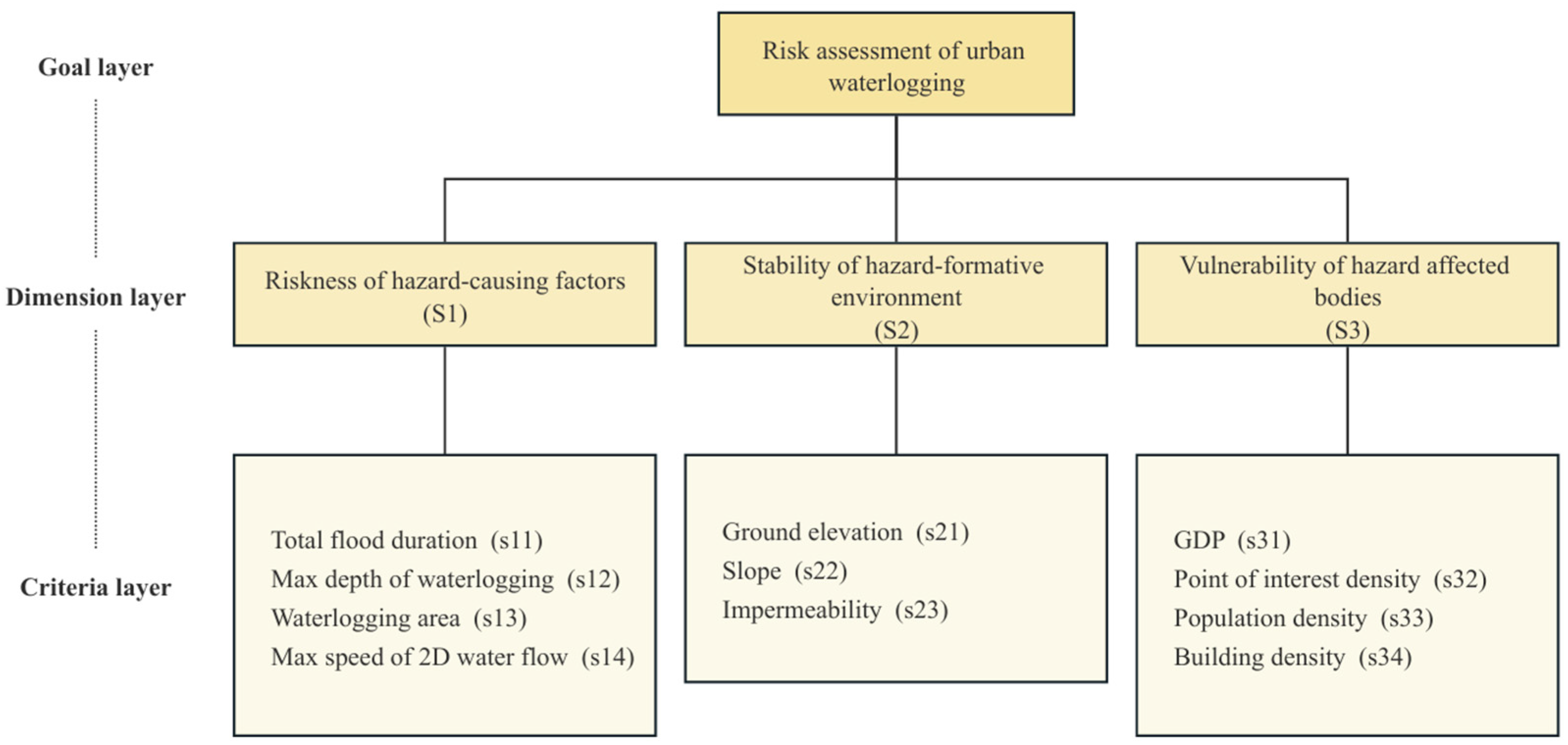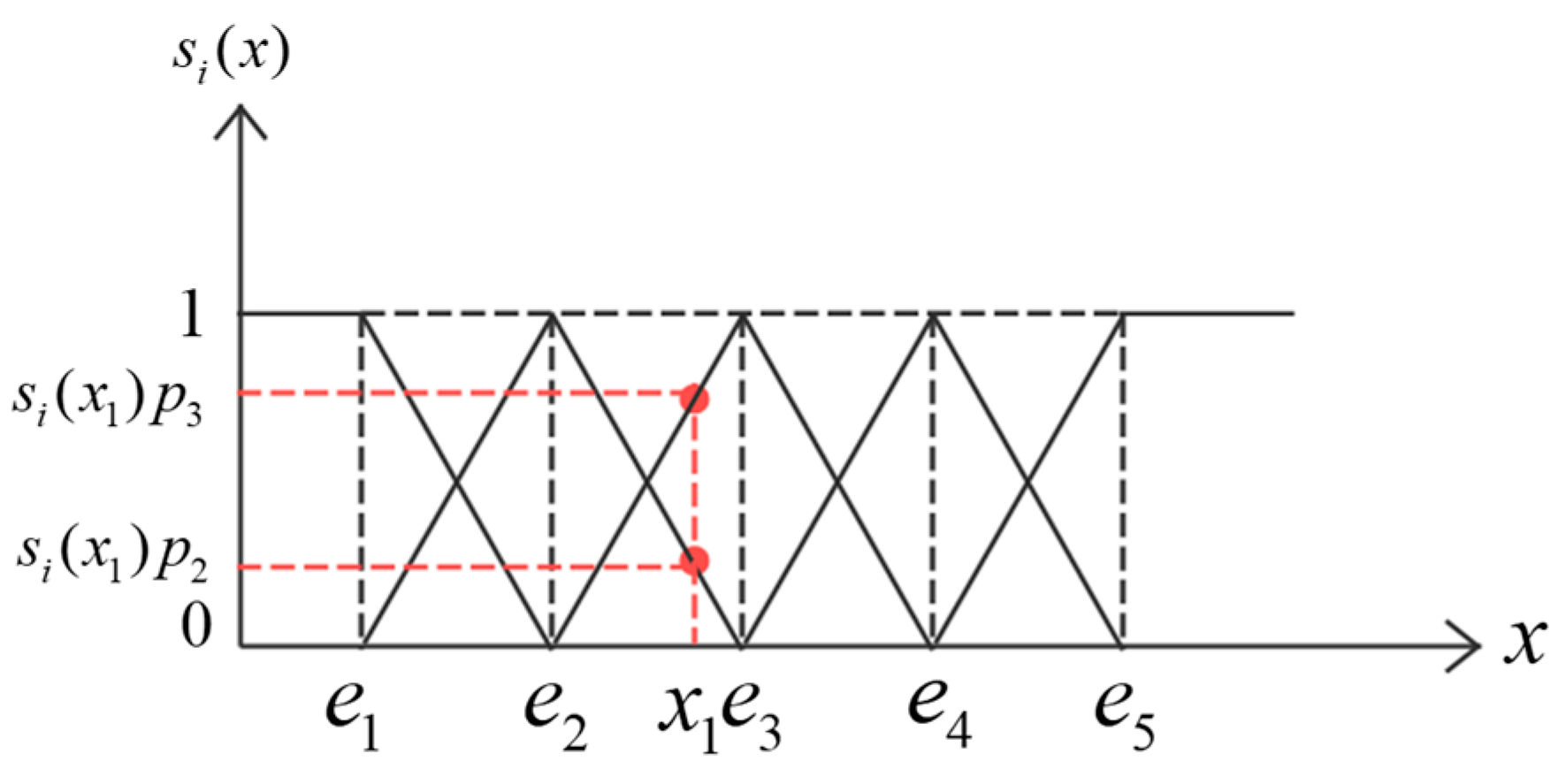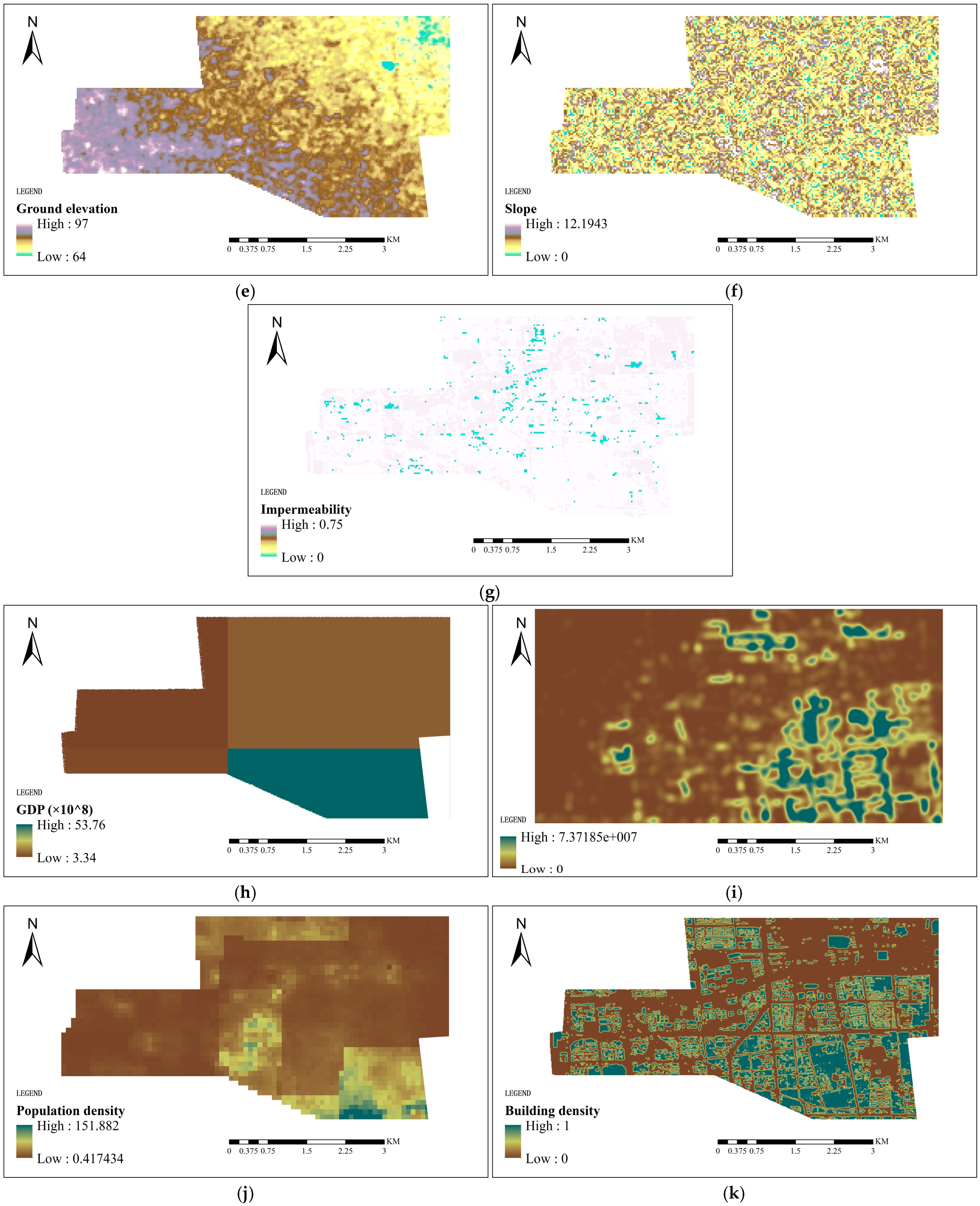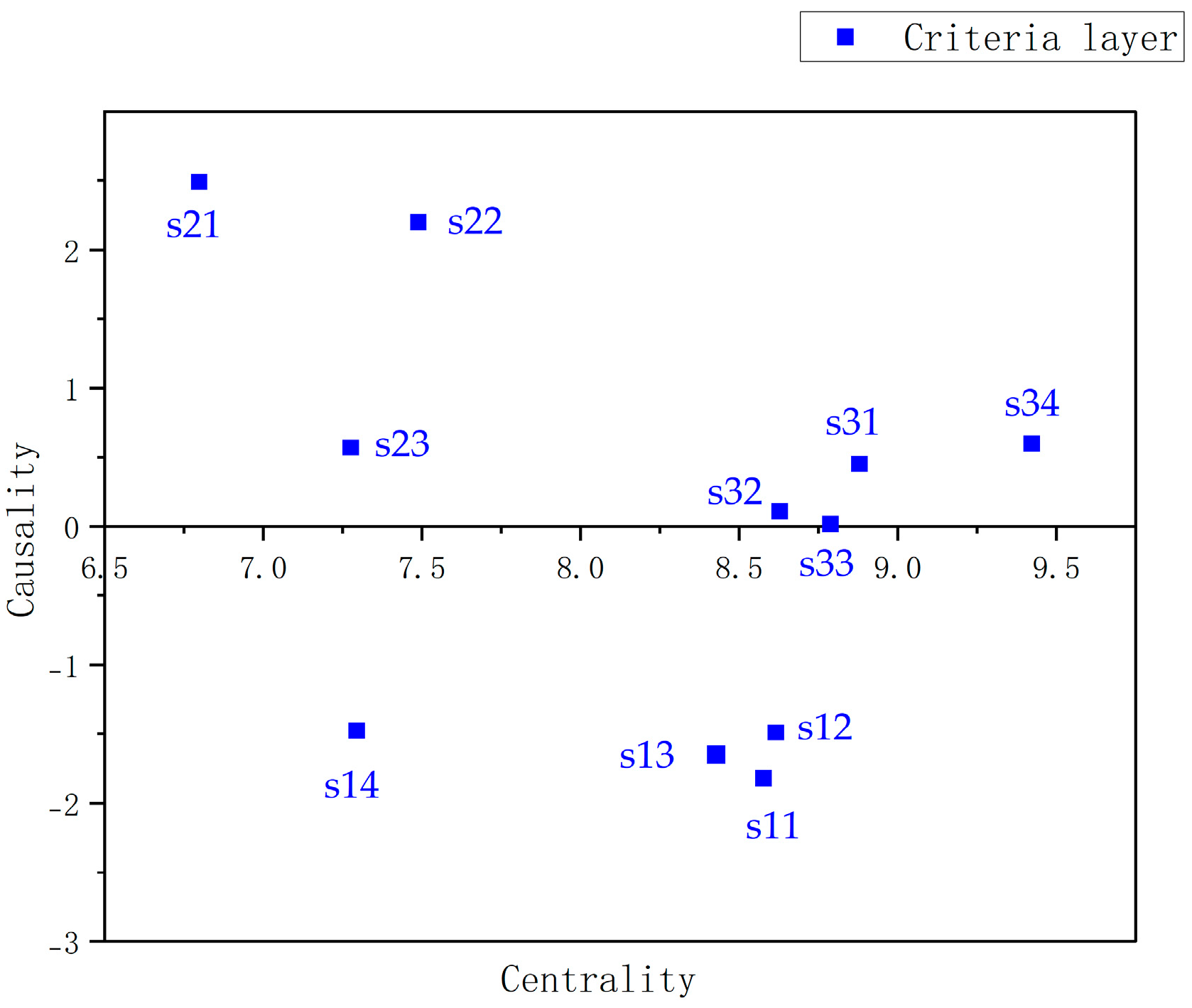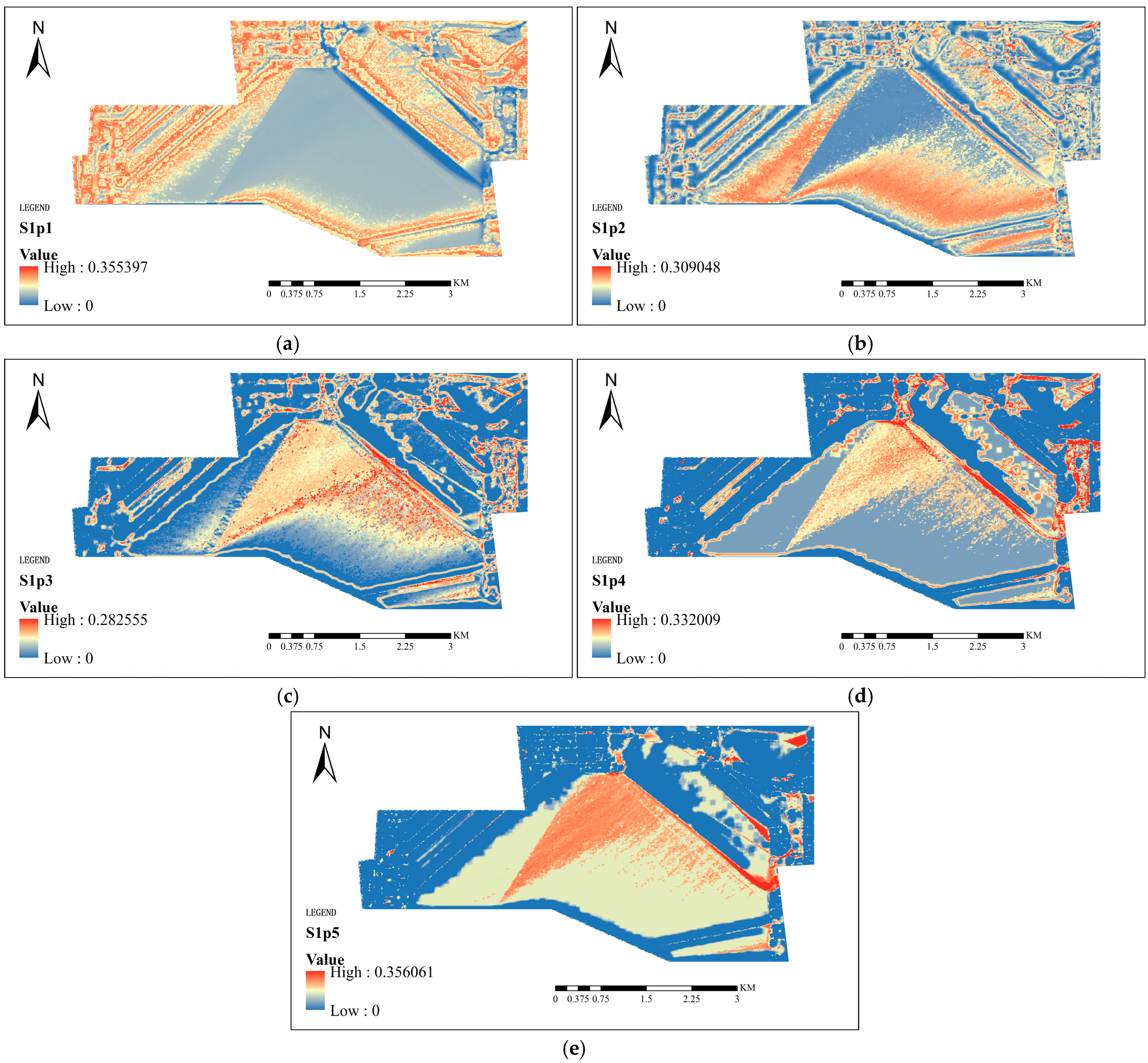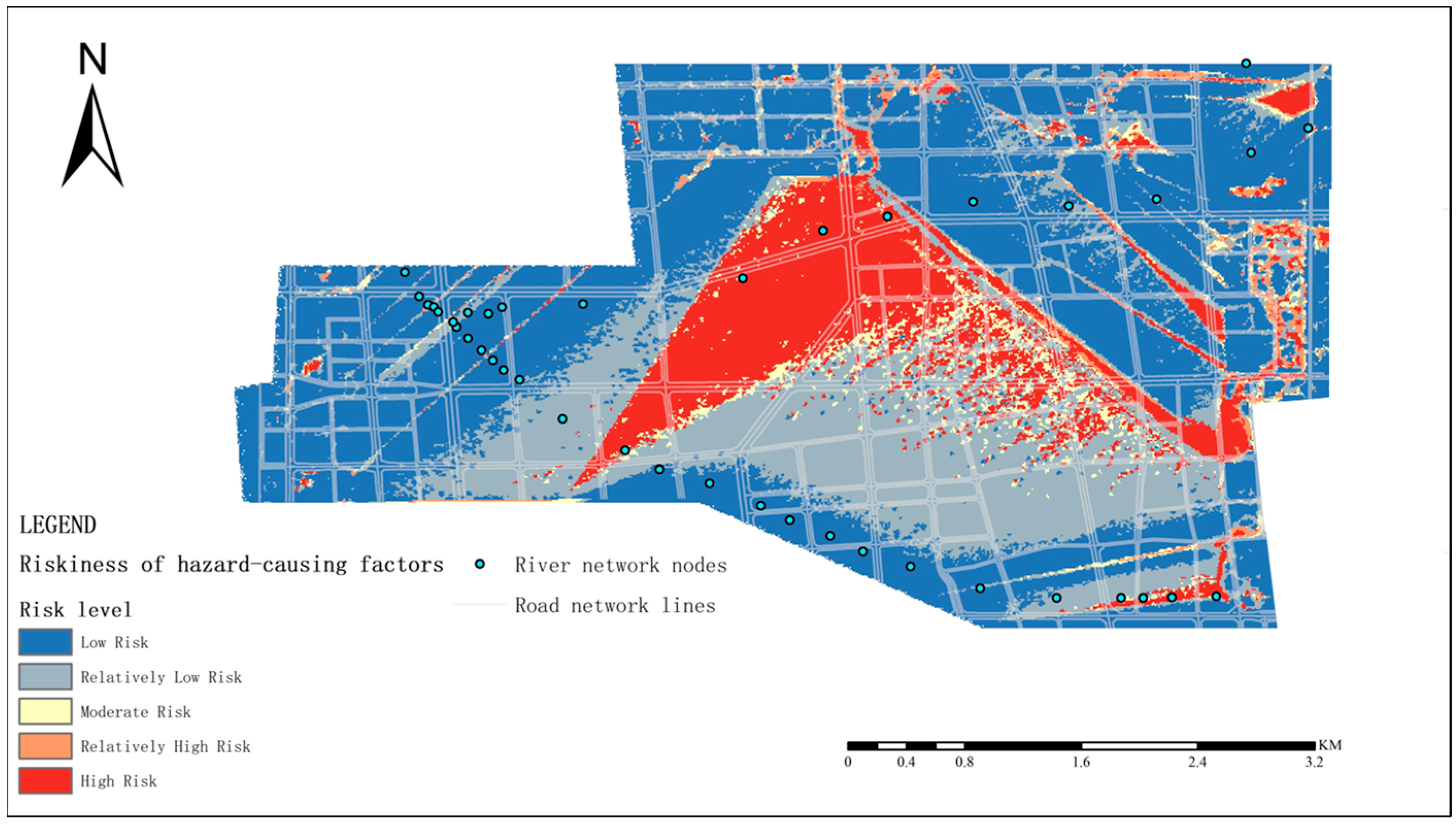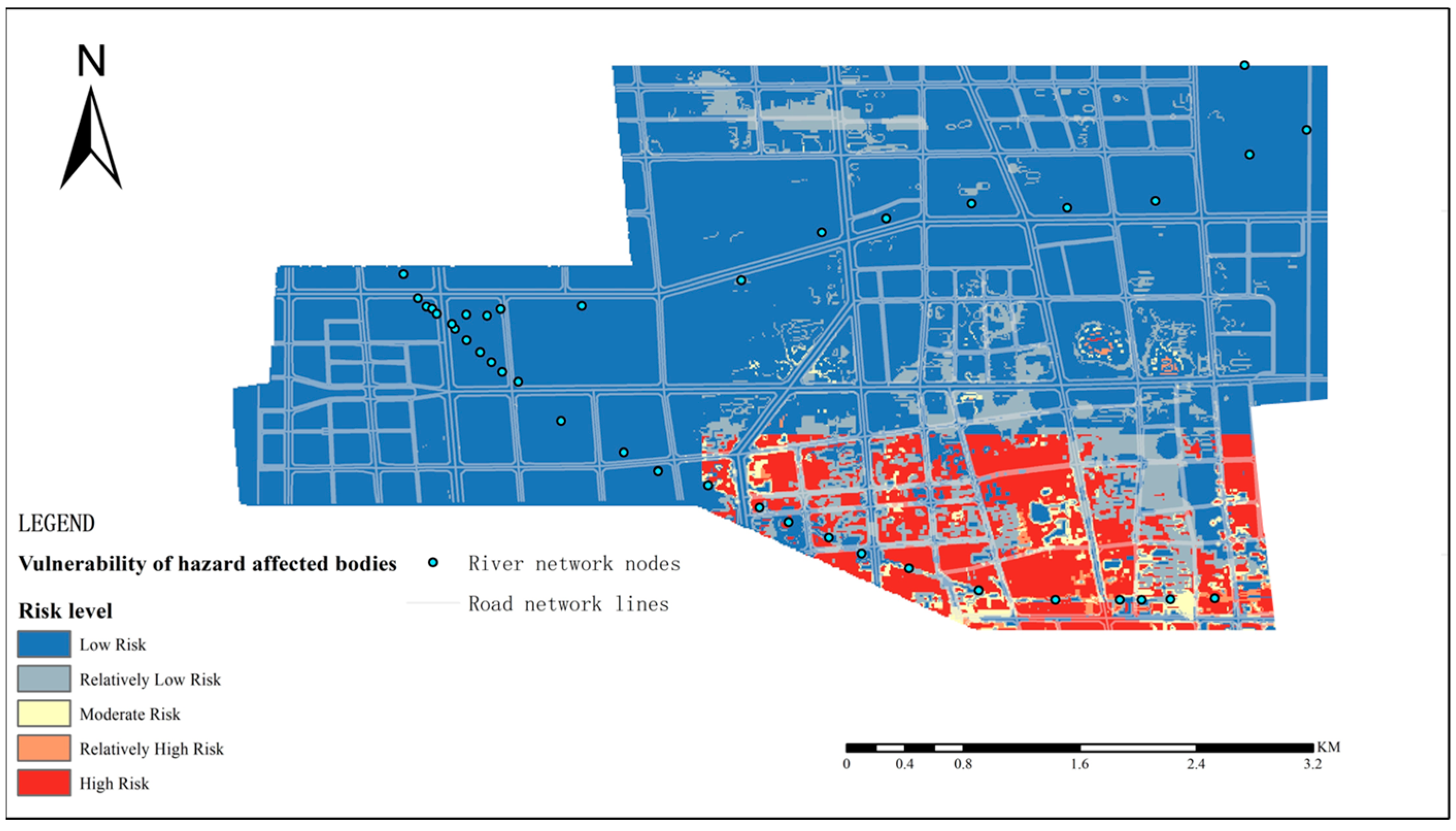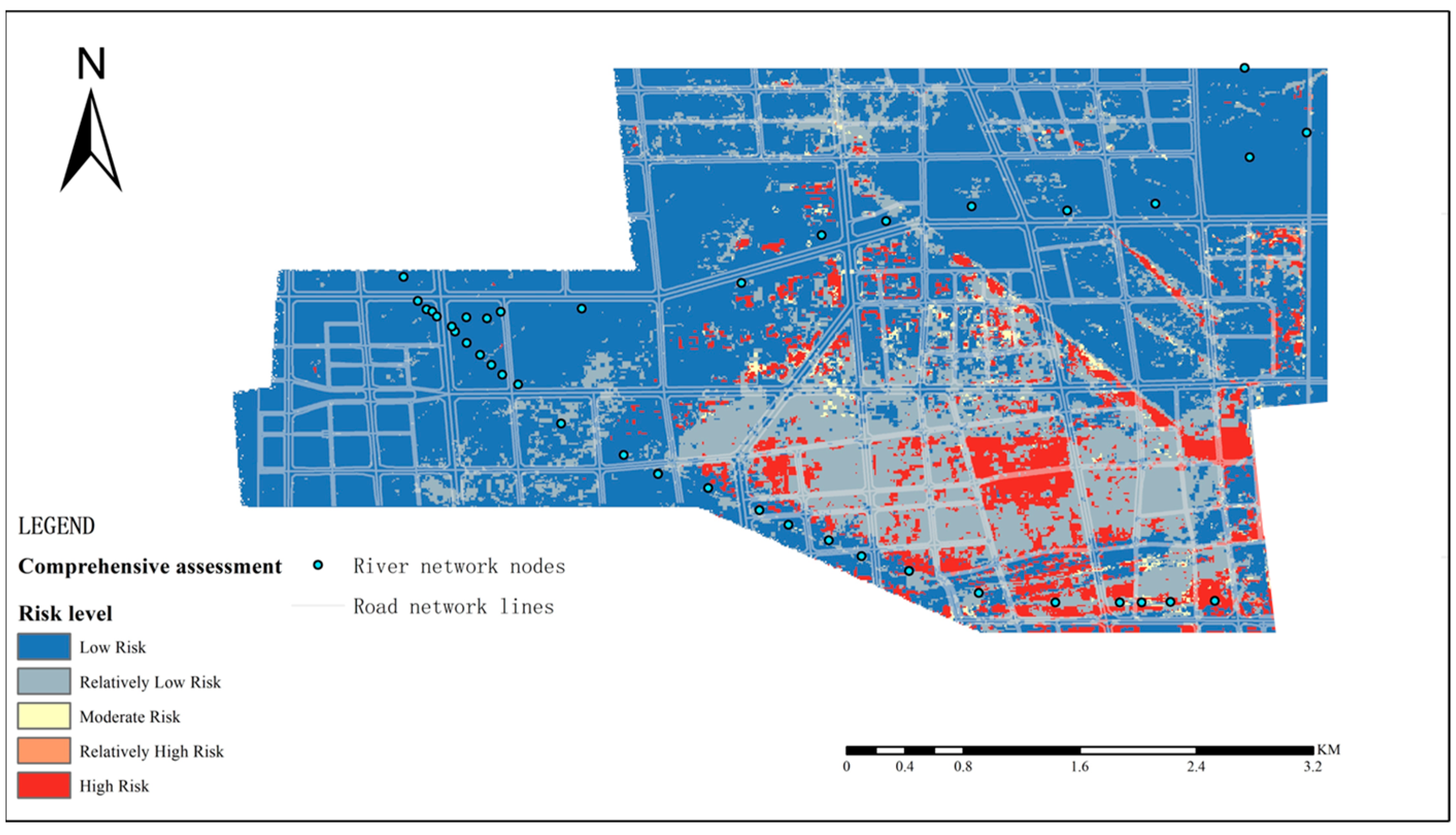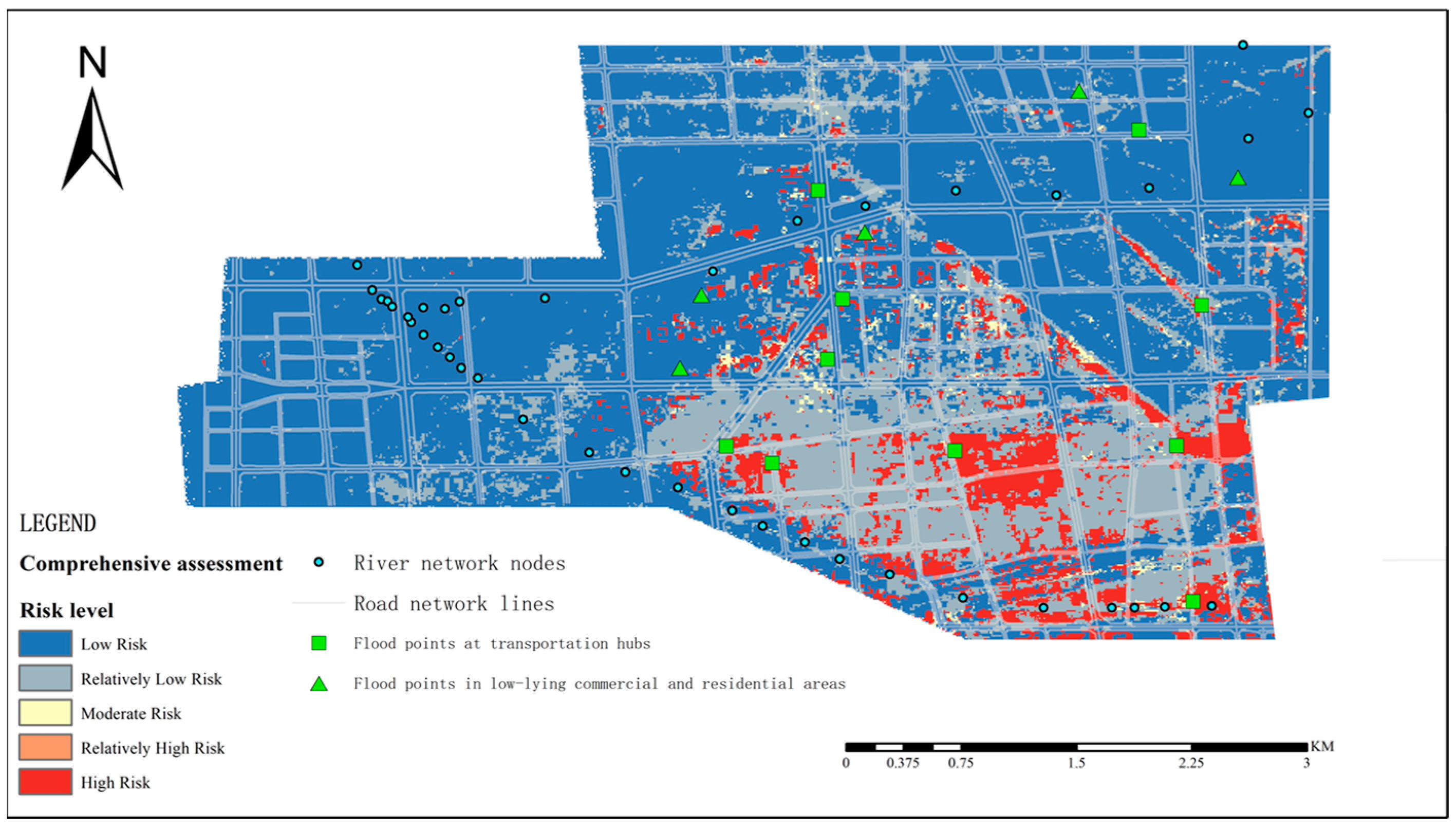1. Introduction
Regarded as a common environmental hazard, frequent urban flood ranks among the most pressing issues facing modern societies [
1]. Urban flood is operationally defined to the occurrence where continuous precipitation or intense rainfall occurs within a short period, exceeding the absorption thresholds of engineered drainage systems and flood prevention capacity of urban areas, resulting in water accumulation and flood disasters [
2]. Currently, the rapid growth of urban areas, along with the resultant climate change and alterations in land-use types, is considered a primary cause of urban flood [
3]. In terms of climate change, carbon dioxide emissions exacerbate the urban heat island effect, leading to an increased frequency of heavy and extreme rainfall events [
4]. Regarding changes in land-use types, the expansion of urbanized land consumption, and the increase in impenetrable ground cover water cycle dynamics such as infiltration, evaporation, and surface runoff, thereby elevating the urban flood risk. Furthermore, unplanned urban growth and inadequate management of drainage facilities are also significant contributors in the emergence of urban flood [
5].
China is suffering from the adverse impacts of urban flood, with the frequency and severity of urban flood incidents continuously increasing. During a three-day period starting 19 July 2021, Zhengzhou experienced an unprecedented torrential rainstorm, resulting in approximately 300 fatalities and affecting 14.786 million residents, with direct economic damages soaring to as much as 53.2 billion yuan [
6]. From 27 July to 1 August 2023, Hebei Province and the surrounding Beijing-Tianjin-Hebei region were struck by extreme heavy rainfall, with localized areas in the Taihang Mountain front receiving over 1000 mm of precipitation [
7]. Approximately 3.8886 million residents in Hebei Province were impacted by this flood disaster, resulting in direct economic damages amounting to 95.811 billion yuan. According to the 2023 China Flood and Drought Disaster Prevention Bulletin, over the decade from 2013 to 2023, tens of millions of people nationwide were affected by flood annually, with direct economic losses exceeding hundreds of billions of yuan each year. It is evident that urban flood disasters have a profound impact on the socio-economic progress of China and the safety and property of its residents.
Although it is impossible to completely prevent the occurrence of heavy rainfall events, effective management of flood risk can significantly mitigate the impacts of flood disasters [
8]. Through flood risk analysis, it is possible to identify potential high-risk locations for flood, enabling the development of appropriate flood-prevention planning and the implementation of various measures aimed at reducing the severity of flood disasters and minimizing associated losses. Given the necessity of flood risk management, selecting appropriate methods for urban flood risk assessment, accurately identifying high-risk areas among numerous classification criteria to implement effective flood prevention and control measures, thereby achieving the goal of managing urban flooding, has emerged as an important area of research [
9].
Currently, there is no unified evaluation standard for flood risk assessment. Scholars have adopted diverse methodologies based on their research focuses, primarily utilizing historical statistical analysis [
10,
11], scenario simulation [
12,
13], and index system methods [
14,
15]. However, each of these methods has its own limitations [
16]. Historical statistical methods rely on accurate, complete, and continuous disaster data, which can be challenging to obtain. Moreover, with the advancement of urbanization, changes in surface environments and meteorological factors have further diminished the applicability of this method. The scenario simulation method only evaluates the riskness of the hazard-causing factors, without incorporating the hazard-formative environment and the hazard-affected bodies into a comprehensive assessment framework, which limits its application in disaster management decision-making that necessitates a thorough evaluation of various factors. In the case of index system method, the indexes are primarily at the urban scale, making it difficult to refine assessments to the street or intersection level, which is not suitable for detailed evaluations of urban flood risks. Therefore, this study adopts a comprehensive method that integrates both the index system method, and scenario-based simulation technique, tackling the limitations in each individual method.
When applying the index system methodology to assess the flood risk, it is crucial to establish the index weights. The determination of index weights is a crucial step in conducting urban flood risk assessments using the index system method. Many methods for assessing the risk of urban flood are based on the Analytic Hierarchy Process (AHP) [
17,
18,
19]. As an example, Duan et al. [
20] considered the AHP method to be a widely accepted Multi-Attribute Decision-Making (MADM) approach, and they employed this method to assess the flood risk in Changchun City. Most MADM methods typically require the assumption of criterion independence, neglecting the intercorrelations that inherently exist among them [
21]. This fundamental premise proves inadequate for urban flood risk assessment where complex interdependencies exist among evaluation indexes [
22]. For instance, topographical factors significantly influences the max depth of flood [
23]. The Analytic Network Process (ANP), a MADM method, can be utilized to determine the weights of indexes while allowing for dependency relationships among them [
24]. However, the ANP method requires multiple pairwise comparisons, and this process is effortful and may lead to inconsistencies in results [
25]. Additionally, the causal dependencies among flood risk indexes remain to be fully explored. The Decision-Making Trial and Evaluation Laboratory (DEMATEL) method, a system developed based on graph theory that employs causal impact diagrams to address complex relationships among indexes [
26], can be applied to resolve this issue and enhance the subjective evaluation limitations of the ANP method [
27]. The DEMATEL-ANP hybrid technique has been successfully applied in the evaluative analysis of various fields, including water resource and environmental management [
28], energy planning [
29], and market analysis [
30]. The DEMATEL-ANP method has seen certain applications in the field of flood risk assessment in recent years [
22,
31,
32]. As evidenced by Taherizadeh et al.’s study [
33], this methodology was successfully applied to develop flood susceptibility maps for Golestan Province, Iran, through systematic integration of remote sensing-derived geomorphological parameters.
In addition, in the course of flood risk assessment, it is essential to determine the risk levels. The term “high risk” is a vague qualitative statement that needs to be transformed into a concept that can be quantitatively evaluated. The fuzzy comprehensive evaluation (FCE) method effectively addresses the ambiguity in risk classification. For instance, Cui et al. [
34] established an urban community resilience framework using the FCE method, which effectively measured the resilience of urban communities in the aftermath of flood disasters. Li et al. [
35] used the FCE method to assess flood risk based on a socio-economic indicator system from both single-factor and multi-factor dimensions. Shaikh et al. [
36] also achieved good flood risk assessment results using linear fuzzy membership functions and the AHP method, finding that the risk maps based on fuzzy logic exhibited the highest consistency when compared to natural breakpoint classification.
This study aims to establish a practical and effective model for assessing flood risk. The assessment model determines index weights through the hybrid DEMATEL-ANP method, combines the FCE method for systematic assessment, and generates risk distribution maps through ArcGIS software 10.2 version, making it suitable for fine-scale assessments within urban areas. The model provides a basis for the planning and implementation of urban flood mitigation measures.
5. Conclusions
Faced with the increasingly severe challenge of urban flood, this study established a risk assessment index system for flood hazards, and obtained the water accumulation data through the Infoworks ICM drainage model. The weights of the indexes were calculated using a hybrid approach combining DEMATEL and ANP methods. Furthermore, this study developed an urban flood risk assessment model employing the FCE method, which facilitated a comprehensive assessment of flood risk. The results are as follows:
Based on the theory of district disaster system, this study has established an index system for flood hazard risk, which includes 3 clusters and 11 indexes. The DEMATEL method was used to analyze the interrelationships among the indexes and establish a network relationship map. The hybrid method of DEMATEL and ANP was employed to assign weights to the indexes.
Taking a drainage zone in Z City as the research object, a 1D drainage model and a 2D urban inundation model based on the Infoworks ICM model were established. A 24 h long-duration rainfall pattern was designed for scenario simulation, and the flood data required for the flood risk assessment was obtained, realizing the integration of the scenario simulation and the index system methodology.
Using the FCE method, this study has established an urban flood risk fuzzy evaluation model with triangular membership functions, conducting fuzzy evaluations of the 11 indexes from the perspectives of hazard-causing factors, hazard-formative environment and hazard-affected bodies, as well as an overall fuzzy evaluation. The study area was categorized into five risk levels: “low risk, relatively low risk, moderate risk, relatively high risk, and high risk”, with area proportions of 68.98%, 22.75%, 0.86%, 0.10%, and 7.31%, respectively. The model’s evaluation accuracy can reach a raster resolution of 10 m × 10 m, making it suitable for detailed simulations within urban environments and providing a basis for the implementation of flood-prevention planning measures.
